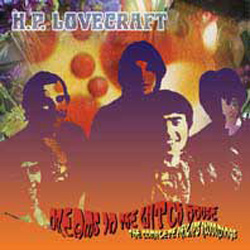
H.P. Lovecraft
H.P. Lovecraft: Dreams in the Witch House
Complete Philips Recordings (Rev-Ola)
Legendary harmony laden folk-psych masters get their Philips label works collected by Rev-Ola.
Originally from Chicago (with a Dunwich Records session men connection) the band relocated to San Francisco in 1967 just in time for the explosion of like-minded folk trippers. Blessed with superior vocal harmonies and a penchant for crafting and performing tunes with darkly impassioned lyrical elements it is no wonder that their fan base has grown over the years. Two albums in the group was pretty much finished. Chart hits eluded them in spite of quality bills and playing some of the nations top clubs.
The visual elements of their best songs combined with a focused and expertly crafted musical component will certainly have fans of the psych/harmony-folk genre hitting the repeat button on their players. (23 tracks.) BUY HERE!
Treacle Toffee World
Treacle Toffee World: Further Pop Psych Sounds
from the Apple Era 1967-1969 (RPM)
A number of unreleased obscurities by the likes of the Iveys, 23rd Turnoff, Grapefruit and Gallagher and Lyle sit alongside better-known classics like Fire’s ”Father’s Name is Dad” and the title track “Treacle Toffee World.”
Balloons, coppers, butterflies, wind, far-away lands and the like are the typical subject matter of the purveyors of classic pop-psych and there is plenty of that here. All delivered of course in a delightfully harmonious, whimsical and occasionally feedback fuelled manner sure to sit nicely alongside your afternoon cuppa. (18 tracks.) BUY HERE!
Bowler Hats & Leather Boots
Bowler Hats & Leather Boots: Personalities Go Pop Art (él)
Oh my goodness. Did you say you were looking for something to help you clear the party? Or did you say you were the type that was looking for the weirdest sort of odd-duck tune to send to your least favourite ex? Well there are plenty of them either however you choose to irritate your enemies. Don’t get me wrong, they aren’t all atrocious but many are just plain, uh, too nuts for fun.
The pain begins with George Melly enunciating the shit out of a bunch of “sounds” then follows through to the excruciating teen plop of Hayley Mills doing a couple of juvenile chalk board scrapers. The collection continues on the stairway to hell with Elke Sommer, Oliver Reed, Dirk Bogarde, David Niven and countless others. I for one have never found Robert Mitchum’s take on “calypso” appealing in any way shape or form. I’d put it right up there with Dick Van Dyke’s cockney if you know what I mean. Thankfully with only one tune.
There is an oddity or two that is sure to appeal to some, like Quentin Crisp’s “Stop the Music for a Moment” or Salvidor Dali’s “Dali Paints a Picture” if only just to hear them speak. Otherwise, AGH! Bizarre, irritating, strange and occasionally oddly compelling but definitely not for your average listener. I will now go and try to expunge the sounds from my memory bank. (36 tracks.) BUY HERE!
John’s Children
John’s Children: A Strange Affair, the Sixties Recordings (Grapefruit)
Any fan of 60s, mod, freakbeat, glam, pre-punk, punk and just plain old classic UK rock’n’roll should consider having this collection in their library. Fair enough a fair chunk of this has been collected elsewhere before but you should still get your hands on this music if you haven’t already. John’s Children are infamous/famous for outrageous on and off stage behaviour, having Marc Bolan in the band in the early days and for having spawned the careers of future Radio Stars/Jet members Andy Ellison and Chris Townson (also in the Jook).
With former Yardbirds manager Simon Napier-Bell as manager of the band the band was able to secure a record deal and wreak havoc far and wide. Even causing a riot in Germany while touring with the Who. It should be noted here too that drummer Chris Townson actually subbed for Keith Moon at one point. To quote the legendary Gorillas front man Jesse Hector when he mentioned this fact to me over a half cider in a Camden pub, “The Who, Colin. You can’t do better than that.” He’s right of course and Chris Towson was a superb drummer. Sadly he passed away a few years back. The band had reformed and played a number of times over the past decade and a half and while Andy and Chris were the sole original members the line-up had also included their former Jet/Radio Stars band mate Martin Gordon on bass as well as Morrissey guitarist and John’s Children mega fan Boz Boorer.
This double disc set is full to the brim with rarities, bonus tracks, the original Orgasm album as well as Andy Ellison solo tracks, And you know what? You can’t do better than that. Essential stuff and a fantastic package conceived and compiled by John Reed. (CD1: 26 tracks. CD2: 26 tracks.) BUY HERE!












